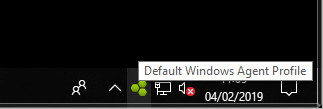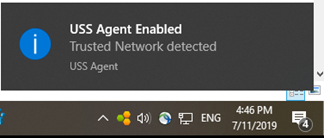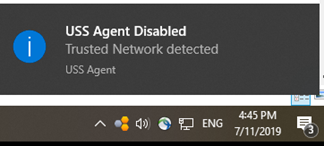Configuration options for the Windows agent type
- Settings
- Profile name / Tray icon tooltip
- Agent Password
- Tag web requests with
- Preferred outbound ports
- Hot Spot mode (Fail Open)
- Check for new updates automatically
- Install new updates when they are available
- Agent can be restarted without password following manual Stop Service action
- Enable popup notifications for blocked downloads
- Hide tray icon on startup
- Allow tray app to be started
- Identification & Privacy
- Bypass Categories
- Agent Anti-Malware
- Network Detection
- Advanced
The Agent Configuration screen allows you to create or modify agent profiles for Windows agents. Selecting a Windows agent profile from the list will allow you to configure the profile.
To see the different Agent Configuration profiles attached to your account, visit your USS Dashboard and click Products ⟶ Web Security ⟶ Agent Configuration.
Settings

Profile name / Tray icon tooltip
A friendly name for the profile to make it easier to manage. The name is also displayed in the tooltip for the agent icon.

Agent Password
The tamper-proof password which secures the configuration and start/stop options on the agent. This password is automatically generated when the profile is created but can be changed.
Tag web requests with
The Tag to assign to this agent. Tags are used to identify the agent in Filter Rules. Select a tag to use, or choose No Selection if a tag is not required.
Preferred outbound ports
The agent will connect to the Web Security cloud service on ports 1344 & 1345 or 80 & 443. Select the preferred ports here and they will be tried first. If a connection is not established, the agent will try the remaining ports.
Hot Spot mode (Fail Open)
If enabled, the agent will provide unfiltered access if for any reason the Web Security cloud service ports are inaccessible. If not enabled, web access will be blocked until the cloud service becomes available again.
Check for new updates automatically
If enabled, the agent will poll for new software updates.
Install new updates when they are available
If enabled, the agent will install new software updates as soon as they are available.
Agent can be restarted without password following manual Stop Service action
If enabled, the agent can be started without a password as long as it was previously stopped using the password.
Enable popup notifications for blocked downloads
If enabled, the agent will attempt to display a notification message from the tray app when a download is blocked by a response scanner e.g. MIME type. Example:

Hide tray icon on startup
If enabled, the agent tray icon will not be visible on startup and cannot be started manually. The icon will be hidden on next restart.
Allow tray app to be started
If ticked, the tray app can be started manually by the user by locating it in the Start menu.
Identification & Privacy
The Identification & Privacy section allows you to control what information to log about your users and their devices.

Log username
Enables the capture of Active Directory or local user credentials. This captures the Active Directory domain and username if the user has logged into a Windows domain, or falls back to capturing the local username if this is not possible.
Capture Type
The type of username to attempt to capture.
Type | Behaviour |
SAMAccountname | For use when the agent is part of an on-premise or hybrid Active Directory domain and the SAM Account name is available. The active user will be captured in the format |
UPN | For use when the agent is part of an Azure Active Directory environment and is signed in to an Azure domain. The active user will be captured in the format |
FQDN | For use when the agent is part of an Azure Active Directory environment. The active user will be captured in the format If the user is not part of a domain, the |
Use hostname as username
Use the device's hostname instead of the captured username. Useful for deployments where no user identification mechanism is provided, or for device-based policy control.
Log device MAC address
Enable capture of the device MAC address for the primary network interface.
Log device IP address
Enable capture of the device IP address for the primary network interface.
Bypass Categories
The Bypass Categories section contains a list of available categories, created in the Bypass section of the Web Security product. Bypass categories provide a way for the agents to trust particular network resources, so that matching traffic does not get filtered by the Web Security cloud service. A number of pre-defined categories are provided as a starting point for common services.

(System) appended to their name.Agent Anti-Malware
upgrade.bitdefender.com and delta updates will be downloaded hourly.
Scanning Engine
Select the preferred Scanning Engine to use. Selecting none will disable anti-malware scanning.
Use Block Template
Select a Web Security template to use if malware is detected.
Ignore Media Content
Check this box to ignore content that cannot be scanned such as streaming video and audio.
Scan small files in memory
Checking this option will allow the agent to store files in memory that are less than 100Mb in size. Files greater than 100Mb will be written to disk before scanning.
Network Detection

The Network Detection feature provides added flexibility when using a combination of the gateway and agent software on the same network. Using Network Detection, you can automatically disable Windows agents when the agent detects a new connection to a recognised network.
For example, you might have a gateway agent deployed at your Head Office, along with a number of remote workers each running a Windows agent. If a remote worker visits Head Office with their Windows device, you could instruct that their filtering is handled by the gateway rather than the local Windows agent.
If the agent detects a "known" network, the system tray icon will change to an orange and green icon, and an alert will be displayed.

If the icon is orange and grey, the USS Agent is currently disabled.

Hostname(s) to detect
Use the [IMAGE add button] to add a hostname. The Windows agent will then monitor for that hostname. If the Expected IP is set to 0.0.0.0/0 then the agent state will change as long as the hostname can be resolved to an IP. If you want to only change state if a specific IP is resolved (recommended), specify the IP in CIDR format.
Agent State
Choose what should happen to the Windows agent if a recognised network is detected (either disable or enable the agent).
Do not disable if ...
In certain scenarios you may not want to automatically disable the agent if the device default gateway or network adaptor matches a certain IP (for example, the IP of a VPN router or network range). Check this box, and select the detection method and then add the IP address or CIDR exceptions to the list underneath.
For matching the Default Gateway, an explicit IP address must be provided.
For matching a Network Adaptor, a CIDR should be entered. All network adaptors on the device will be checked to see if their IP falls within the CIDR range.
Multiple Networks
If the Windows agent is installed on a device with multiple network interfaces, the Network Detection configuration will be applied to each interface separately.
Advanced

Use strict SSL/TLS ciphers
If enabled, the agent will reject connections to Web servers that are configured to use old, deprecated or insecure ciphers (such as rc4 and rc4-md5). This may cause third-party services to stop working. Generally, a web browser will always try and negotiate at the highest possible cipher level supported by the web server.
Block QUIC protocol
The QUIC protocol is developed by Google, and is used by many of their services, such as Google Search and GSuite (when accessed via the Google Chrome browser). As QUIC is a variation of HTTP/S over UDP, it can bypass filtering. Enabling this option ensures the protocol is blocked, and therefore the services fall back to using HTTP/S over TCP and can be filtered appropriately.
Intercept all running processes
The agent has the capability to intercept HTTP/S traffic from any running process, but by default this is limited to set of known browser-based applications (listed below). Enabling this option allows interception of any application, however it will be limited to the intercept ports 80 and 443.
Known browser-based applications intercepted by default
- Internet Explorer
- Chrome
- Firefox
- Edge
- Safari
- Vivaldi
- Opera
- Brave
- Google Earth
- UC Browser
Connection Test Before Accept
On by default for new configuration profiles. This feature uses advanced connection handling to avoid conflicts with other endpoint security software. In some cases, it is necessary to disable this feature otherwise it is safe to leave it on. Prior to this option being available it would be set via the registry using the test_connect_before_accept registry key in HKEY_LOCAL_MACHINE\SOFTWARE\USSAgent. Setting this option here overrides the registry setting if it exists.
Connection Timeout
Used in conjunction with Connection Test Before Accept this is the amount of time to wait before assuming a connection has timed out. The default is 30 seconds and there should be no need to change this.
Service hostname
The service hostname is determined by the region chosen for the Web Security service, and cannot be changed directly.
Automatic Update repository (URL)
Select the preferred repository for software updates.
Check for updates every
Specify the frequency with which to check for new software updates.
Whitelist URL
This can be used to create a custom list of applications for the agent to intercept, and should be used with the Intercept all running processes option detailed above. A version of the json file should be hosted on a public web server and must follow the same format as the original.
Local Proxy Port
Specify the port that the agent service should use to receive web requests after they have been intercepted.
Maximum scan size (Mb)
The maximum file size that will be scanned by active response scanning modules, i.e. MIME Type.
Profile ID
An internal ID of the agent profile which may be requested by the Service Provider during a troubleshooting session. This ID cannot be changed.
TLS Certificate
The TLS Certificate section allows you to add your own certificate (Bring-Your-Own-Certificate) or generate a certificate that all Windows agents will use that share this configuration profile. This will replace the self-signed certificate that is unique to each agent (default behaviour).
The following options are available:

- Add Certificate - provide your own public and private key pair that all agents using this configuration will use
- Generate Self-Signed - generate a new self-signed certificate that all agents using this configuration will use
- Copy - copy the public key to the clipboard for ease of transferring to the local certificate store or MDM software
- Download - download the public key for ease of transferring o the local certificate store or MDM software
- Clear Certificate - remove the custom or self-signed certificate. The agent will revert to using its own self-signed certificate which will be different for all agents using this configuration profile